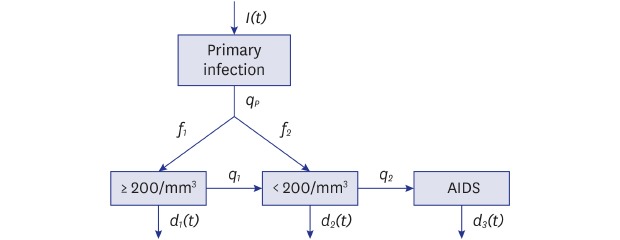- Record: found
- Abstract: found
- Article: found
Estimation of the Number of HIV Infections and Time to Diagnosis in the Korea

Read this article at
Abstract
Background
Statistical data of undiagnosed people living with human immunodeficiency virus (PLHIV) are of great importance to human immunodeficiency virus (HIV) infection control. This study estimated the total number of PLHIV using nationwide claims data.
Methods
This study used data of the incident HIV cases identified by the National Health Insurance System between 2009 and 2015. The number of patients with acquired immune deficiency syndrome (AIDS) was identified by diagnoses or prescription records. The estimated number of PLHIV and the time to diagnosis were calculated from the incident numbers of HIV and AIDS cases using the HIV Modeling Tool of the European Center for Disease Prevention and Control.
Results
Between 2009 and 2015, a total of 7,033 PLHIV and 2,899 AIDS patients were diagnosed. In 2009, the number of incident HIV cases was 873 (460 AIDS patients), increasing to 995 (337 AIDS patients) in 2015. Besides, the estimated number of prevalent cases was 10,753 in 2009, compared to 14,880 in 2015. Patients visiting health facilities accounted for 42.9% (4,616/10,753) in 2009 and 64.1% (9,544/14,880) in 2015. In 2009, there were 8,363 (77.8%) undiagnosed HIV cases, experiencing a decline to 6,215 (41.8%) in 2015. It took a mean of 6.96 years to diagnose after HIV infection.
Conclusion
This study estimates the total burden of HIV infection in Korea for the first time using an internationally recognized HIV modeling tool. Claims data can be used to estimate the number of undiagnosed cases by identifying the total number of PLHIV and AIDS patients visiting health facilities.
Graphical Abstract

Related collections
Most cited references17
- Record: found
- Abstract: found
- Article: not found
Estimation of HIV incidence in the United States.
- Record: found
- Abstract: found
- Article: not found
Guidelines for prevention and treatment of opportunistic infections in HIV-infected adults and adolescents: recommendations from CDC, the National Institutes of Health, and the HIV Medicine Association of the Infectious Diseases Society of America.
- Record: found
- Abstract: found
- Article: found